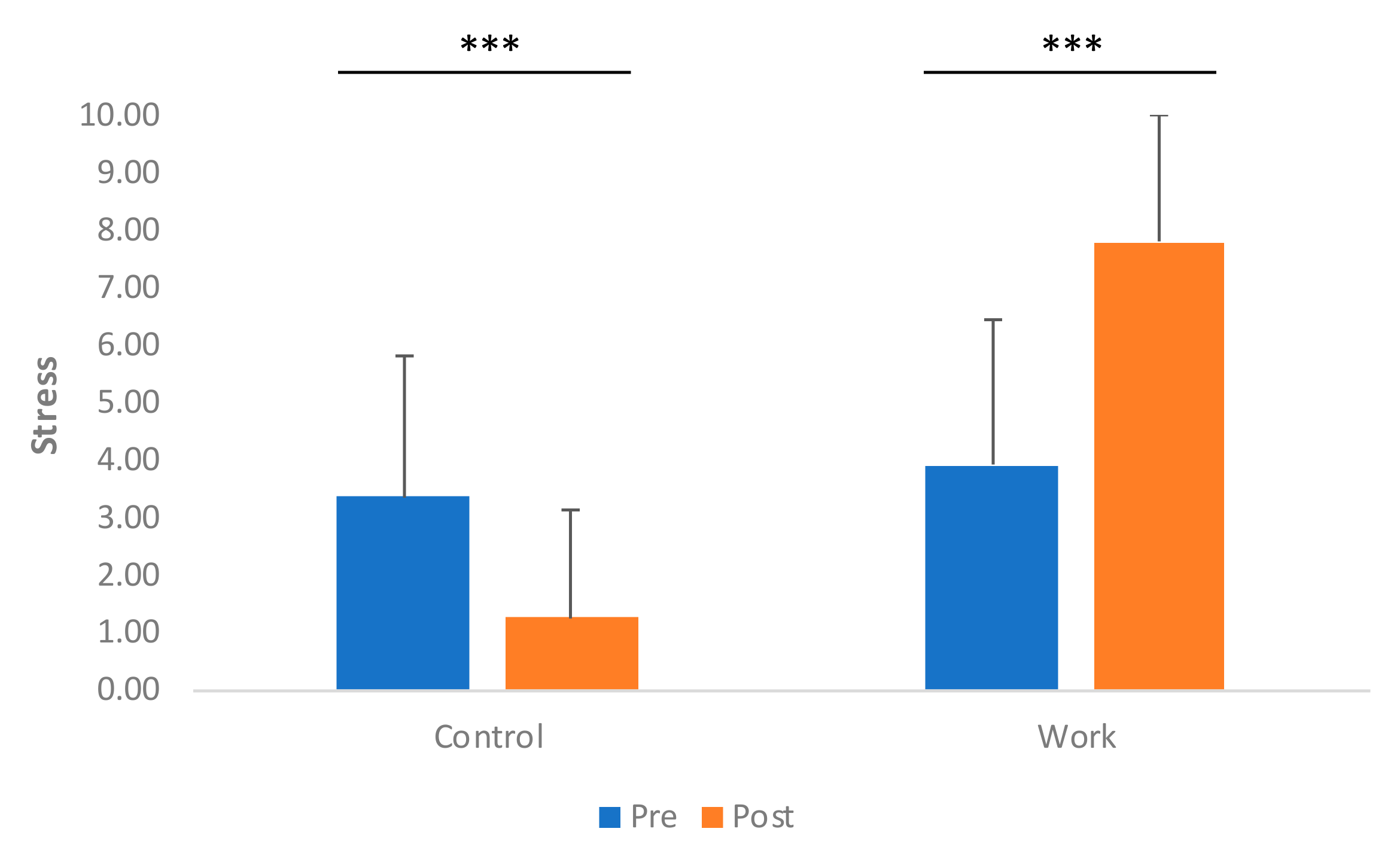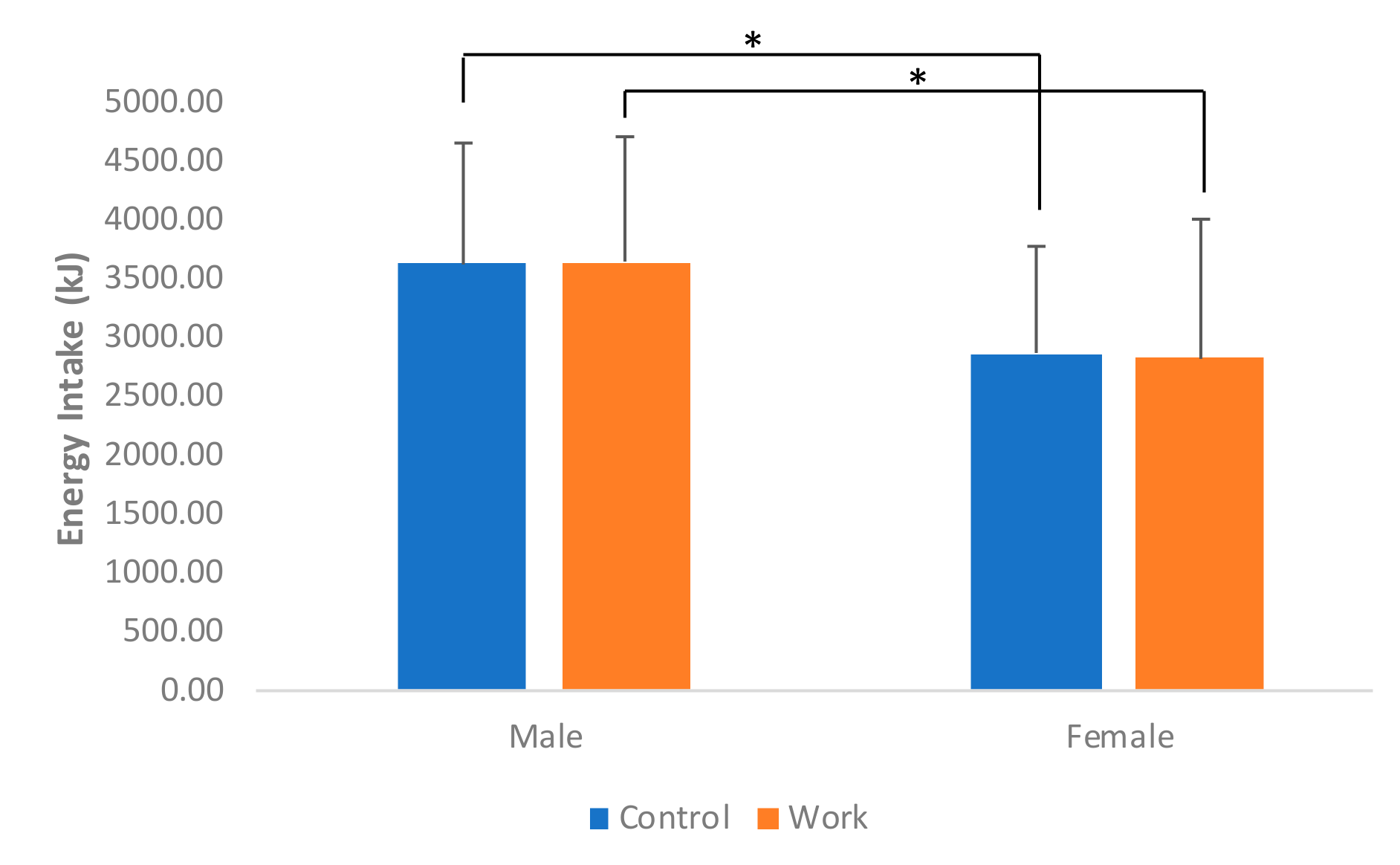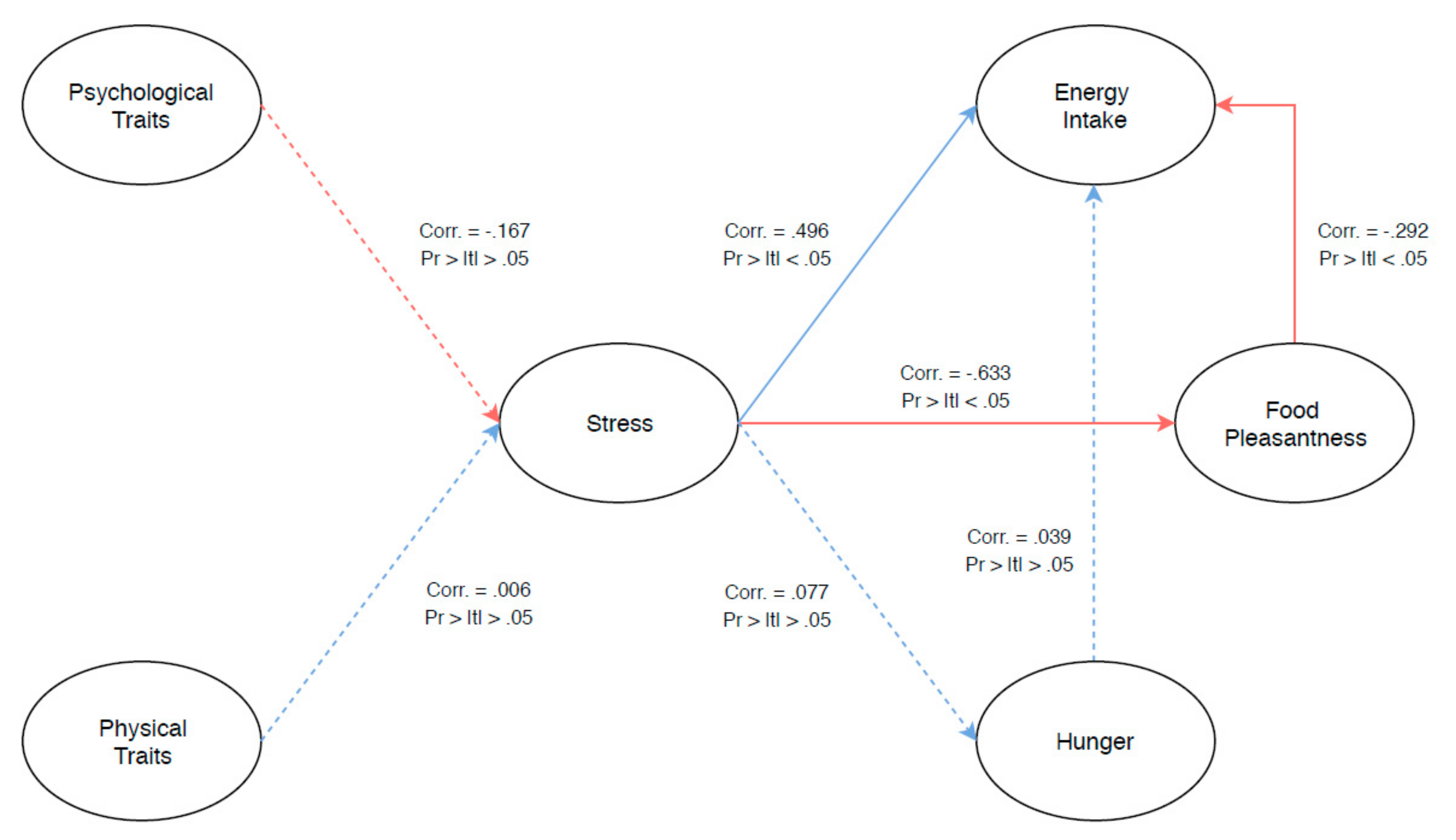How is Satiety Affected When Consuming Food While Working on A Computer?
Abstract
1. Introduction
2. Materials and Methods
2.1. Participants
2.2. Experimental Design
2.3. Food stimulus
2.4. Experimental Procedure
2.5. Measurements
2.5.1. Demographic (BMI and Waist Circumference)
2.5.2. Dutch Eating Behavior Questionnaire
2.5.3. State–Trait Anxiety Inventory Questionnaire
2.5.4. Single Item Stress Scale
2.5.5. Satiety and Food Pleasantness
2.5.6. Food Intake
2.6. Statistical Analysis
3. Results
3.1. Participant Characteristics
3.2. Work Induces Stress
3.3. Overall Influence of Physical and Psychological Characteristics
3.4. Partial Least Square Path Modeling
4. Discussion
4.1. Eating while Working Influenced Stress
4.2. Energy Intake in Work and Control Conditions Was the Same
4.3. Stress Drives an Increase on Energy Intake
4.4. Gender Variation on Energy Intake
4.5. Hunger Level Was Higher in the Work Condition
4.6. Energy Intake Did Not Differ between Restrained and Non-Restrained Eaters
5. Conclusions
Author Contributions
Funding
Conflicts of Interest
References
- WHO. Obesity and Overweight. Available online: http://www.who.int/news-room/fact-sheets/detail/obesity-and-overweight (accessed on 16 February 2018).
- Blass, E.; Anderson, D.; Kirkorian, H.; Pempek, T.; Price, I.; Koleini, M. On the road to obesity: Television viewing increases intake of high-density foods. Physiol. Behav. 2006, 88, 597–604. [Google Scholar] [CrossRef] [PubMed]
- Hetherington, M.; Anderson, A.; Norton, G.; Newson, L. Situational effects on meal intake: A comparison of eating alone and eating with others. Physiol. Behav. 2006, 88, 498–505. [Google Scholar] [CrossRef] [PubMed]
- Bellisle, F.; Dalix, A.M.; Slama, G. Non food-related environmental stimuli induce increased meal intake in healthy women: Comparison of television viewing versus listening to a recorded story in laboratory settings. Appetite 2004, 43, 175–180. [Google Scholar] [CrossRef] [PubMed]
- Bellisle, F.; Dalix, A.-M.; Airinei, G.; Hercberg, S.; Péneau, S. Influence of dietary restraint and environmental factors on meal size in normal-weight women. A laboratory study. Appetite 2009, 53, 309–313. [Google Scholar] [CrossRef] [PubMed]
- Higgs, S.; Woodward, M. Television watching during lunch increases afternoon snack intake of young women. Appetite 2009, 52, 39–43. [Google Scholar] [CrossRef] [PubMed]
- Ogden, J.; Coop, N.; Cousins, C.; Crump, R.; Field, L.; Hughes, S.; Woodger, N. Distraction, the desire to eat and food intake. Towards an expanded model of mindless eating. Appetite 2013, 62, 119–126. [Google Scholar] [CrossRef]
- Herman, C.; Polivy, J. Normative influences on food intake. Physiol. Behav. 2005, 86, 762–772. [Google Scholar] [CrossRef]
- Bellisle, F.; Dalix, A.-M. Cognitive restraint can be offset by distraction, leading to increased meal intake in women. Am. J. Clin. Nutr. 2001, 74, 197–200. [Google Scholar] [CrossRef]
- Benelam, B. Satiation, satiety and their effects on eating behaviour. Nutr. Bull. 2009, 34, 126–173. [Google Scholar] [CrossRef]
- Campbell, C.L.; Wagoner, T.B.; Foegeding, E.A. Designing foods for satiety: The roles of food structure and oral processing in satiation and satiety. Food Struct. 2017, 13, 1–12. [Google Scholar] [CrossRef]
- Oldham-Cooper, R.E.; Hardman, C.A.; Nicoll, C.E.; Rogers, P.J.; Brunstrom, J.M. Playing a computer game during lunch affects fullness, memory for lunch, and later snack intake. Am. J. Clin. Nutr. 2010, 93, 308–313. [Google Scholar] [CrossRef] [PubMed]
- Mitchell, G.L.; Brunstrom, J.M. Everyday dietary behaviour and the relationship between attention and meal size. Appetite 2005, 45, 344–355. [Google Scholar] [CrossRef] [PubMed]
- Born, J.M.; Lemmens, S.G.T.; Rutters, F.; Nieuwenhuizen, A.G.; Formisano, E.; Goebel, R.; Westerterp-Plantenga, M.S. Acute stress and food-related reward activation in the brain during food choice during eating in the absence of hunger. Int. J. Obes. 2009, 34, 172–181. [Google Scholar] [CrossRef] [PubMed]
- Chaput, J.-P.; Tremblay, A. Acute effects of knowledge-based work on feeding behavior and energy intake. Physiol. Behav. 2007, 90, 66–72. [Google Scholar] [CrossRef] [PubMed]
- Rutters, F.; Nieuwenhuizen, A.G.; Lemmens, S.G.T.; Born, J.M.; Westerterp-Plantenga, M.S. Acute Stress-related Changes in Eating in the Absence of Hunger. Obesity 2009, 17, 72–77. [Google Scholar] [CrossRef]
- Chaput, J.-P.; Drapeau, V.; Poirier, P.; Teasdale, N.; Tremblay, A. Glycemic Instability and Spontaneous Energy Intake: Association with Knowledge-Based Work. Psychosom. Med. 2008, 70, 797–804. [Google Scholar] [CrossRef] [PubMed]
- Salama, M.; Drapeau, V.; Tremblay, A.; Pérusse-Lachance, É. The impact of a mental work on food preferences, eating behavior traits and satiety efficiency. Physiol. Behav. 2016, 154, 191–195. [Google Scholar] [CrossRef]
- Herman, C.P. Restrained Eating. Psychiatr. Clin. N. Am. 1978, 1, 593–607. [Google Scholar] [CrossRef]
- Zellner, D.A.; Loaiza, S.; Gonzalez, Z.; Pita, J.; Morales, J.; Pecora, D.; Wolf, A. Food selection changes under stress. Physiol. Behav. 2006, 87, 789–793. [Google Scholar] [CrossRef]
- Royal, J.D.; Kurtz, J.L. I ate what?! The effect of stress and dispositional eating style on food intake and behavioral awareness. Personal. Individ. Differ. 2010, 49, 565–569. [Google Scholar] [CrossRef]
- Cohen, J. Statistical Power Analysis for the Behavioral Sciences; Taylor and Francis: Hoboken, NJ, USA, 2013. [Google Scholar]
- Van Strien, T.; Frijters, J.E.R.; Bergers, G.P.A.; Defares, P.B. The Dutch Eating Behavior Questionnaire (DEBQ) for assessment of restrained, emotional, and external eating behavior. Int. J. Eat. Disord. 1986, 5, 295–315. [Google Scholar] [CrossRef]
- Spielberger, C.D.; Edwards, C.D.; Montouri, J.; Lushene, R. State-Trait Anxiety Inventory for Children. In PsycTESTS Dataset; American Psychological Association (APA): Washington, DC, USA, 1973. [Google Scholar] [CrossRef]
- Karvounides, D.; Simpson, P.M.; Davies, W.H.; Khan, K.A.; Weisman, S.J.; Hainsworth, K.R. Three studies supporting the initial validation of the stress numerical rating scale-11 (Stress NRS-11): A single item measure of momentary stress for adolescents and adults. Pediatr. Dimens 2016, 1, 105–109. [Google Scholar] [CrossRef]
- Dalton, M.; Finlayson, G.; Esdaile, E.; King, N. Appetite, Satiety, and Food Reward in Obese Individuals: A Behavioral Phenotype Approach. Curr. Nutr. Rep. 2013, 2, 207–215. [Google Scholar] [CrossRef]
- Van Strien, T.; Peter Herman, C.; Engels, R.C.M.E.; Larsen, J.K.; van Leeuwe, J.F.J. Construct validation of the Restraint Scale in normal-weight and overweight females. Appetite 2007, 49, 109–121. [Google Scholar] [CrossRef] [PubMed]
- Van Strien, T.; Oosterveld, P. The children’s DEBQ for assessment of restrained, emotional, and external eating in 7-to 12-year-old children. Int. J. Eat. Disord. 2008, 41, 72–81. [Google Scholar] [CrossRef] [PubMed]
- Patel, B.P.; Bellissimo, N.; Thomas, S.G.; Hamilton, J.K.; Anderson, G.H. Television Viewing at Mealtime Reduces Caloric Compensation in Peripubertal, But Not Postpubertal, Girls. Pediatr. Res. 2011, 70, 513–517. [Google Scholar] [CrossRef] [PubMed]
- Martens, R.; Burton, D.; Vealey, R.S.; Bump, L.; Smith, D.E. Competitive State Anxiety Inventory—2. In PsycTESTS Dataset; American Psychological Association (APA): Washington, DC, USA, 1983. [Google Scholar] [CrossRef]
- Flint, A.; Raben, A.; Blundell, J.E.; Astrup, A. Reproducibility, power and validity of visual analogue scales in assessment of appetite sensations in single test meal studies. Int. J. Obes. 2000, 24, 38–48. [Google Scholar] [CrossRef]
- Blundell, J.; de Graaf, C.; Hulshof, T.; Jebb, S.; Livingstone, B.; Lluch, A.; Mela, D.; Salah, S.; Schuring, E.; van der Knaap, H.; et al. Appetite control: Methodological aspects of the evaluation of foods. Obes. Rev. 2010, 11, 251–270. [Google Scholar] [CrossRef]
- Kral, T.V.E.; Roe, L.S.; Rolls, B.J. Combined effects of energy density and portion size on energy intake in women. Am. J. Clin. Nutr. 2004, 79, 962–968. [Google Scholar] [CrossRef]
- Hess, J.M.; Wang, Q.; Kraft, C.; Slavin, J.L. Impact of Agaricus bisporus mushroom consumption on satiety and food intake. Appetite 2017, 117, 179–185. [Google Scholar] [CrossRef]
- Lau, E.R.L.; Henry, C.J. No influence of carbonation on glycemic response, gastric emptying, and satiety of sweetened drinks. Nutrition 2017, 39–40, 1–7. [Google Scholar] [CrossRef] [PubMed]
- Lemmens, S.G.; Rutters, F.; Born, J.M.; Westerterp-Plantenga, M.S. Stress augments food ‘wanting’ and energy intake in visceral overweight subjects in the absence of hunger. Physiol. Behav. 2011, 103, 157–163. [Google Scholar] [CrossRef] [PubMed]
- Siervo, M.; Gan, J.; Fewtrell, M.S.; Cortina-Borja, M.; Wells, J.C.K. Acute effects of video-game playing versus television viewing on stress markers and food intake in overweight and obese young men: A randomised controlled trial. Appetite 2018, 120, 100–108. [Google Scholar] [CrossRef] [PubMed]
- Torres, S.J.; Nowson, C.A. Relationship between stress, eating behavior, and obesity. Nutrition 2007, 23, 887–894. [Google Scholar] [CrossRef] [PubMed]
- Papies, E.K.; Stroebe, W.; Aarts, H. Healthy Cognition: Processes of Self-Regulatory Success in Restrained Eating. Personal. Soc. Psychol. Bull. 2008, 34, 1290–1300. [Google Scholar] [CrossRef]
- Higgs, S.; Donohoe, J.E. Focusing on food during lunch enhances lunch memory and decreases later snack intake. Appetite 2011, 57, 202–206. [Google Scholar] [CrossRef] [PubMed]
- Long, S.; Meyer, C.; Leung, N.; Wallis, D.J. Effects of distraction and focused attention on actual and perceived food intake in females with non-clinical eating psychopathology. Appetite 2011, 56, 350–356. [Google Scholar] [CrossRef]
- Chaput, J.-P.; Visby, T.; Nyby, S.; Klingenberg, L.; Gregersen, N.T.; Tremblay, A.; Astrup, A.; Sjödin, A. Video game playing increases food intake in adolescents: A randomized crossover study. Am. J. Clin. Nutr. 2011, 93, 1196–1203. [Google Scholar] [CrossRef]
- Groesz, L.M.; McCoy, S.; Carl, J.; Saslow, L.; Stewart, J.; Adler, N.; Laraia, B.; Epel, E. What is eating you? Stress and the drive to eat. Appetite 2012, 58, 717–721. [Google Scholar] [CrossRef]
- Kantono, K.; Hamid, N.; Shepherd, D.; Lin, Y.; Skiredj, S.; Carr, B. Emotional and electrophysiological measures correlate to flavour perception in the presence of music. Physiol. Behav. 2019, 199, 154–164. [Google Scholar] [CrossRef]
- Xu, Y.; Hamid, N.; Shepherd, D.; Kantono, K.; Spence, C. Changes in flavour, emotion, and electrophysiological measurements when consuming chocolate ice cream in different eating environments. Food Qual. Prefer. 2019, 77, 191–205. [Google Scholar] [CrossRef]




| Questions | Anchors | Reference |
|---|---|---|
| How hungry are you right now? | Not at all hungry and extremely hungry | [33] |
| How full do you feel? | Not at all full and totally full | [34] |
| How strong is your desire to eat now? | Very weak and very strong | [35] |
| How much pizza do you think you could consume right now? | Nothing at all and a large amount | [33] |
| How satiated do you feel? | I am completely empty and I cannot eat another bite | [34] |
| Questions | Anchors | Reference |
|---|---|---|
| How pleasant is the appearance of the pizza right now? | Not at all pleasant and extremely pleasant | [33] |
| How pleasant is the odor of the pizza right now? | ||
| How pleasant did you find the pizza? | ||
| How pleasant do you think this pizza would taste right now? | ||
| How much do you think you would enjoy eating this pizza? | Not at all and extremely |
| Total (n = 43) | Male (n = 14) | Female (n = 29) | |
|---|---|---|---|
| Age (years) | 25.79 ± 4.87 (19–24) | 25.29 ± 4.43 (20–38) | 26.03 ± 5.12 (19–41) |
| BMI (kg/m2) | 21.75 ± 2.75 (16.49–27.78) | 22.28 ± 2.59 (16.98–26.31) | 21.50 ± 2.83 (16.49–27.78) |
| Waist (cm) | 76.08 ± 7.25 (62–90) | 79.79 ± 6.72 (68–90) | 74.29 ± 6.90 (62–90) |
| DEBQ restraint eating | 2.46 ± 0.77 (1–4) | 2.34 ± 0.90 (1–3.8) | 2.51 ± 0.71 (1.1–4) |
| DEBQ emotional eating | 2.49 ± 1.04 (1–4.92) | 2.36 ± 1.26 (1–4.77) | 2.56 ± 0.94 (1–4.92) |
| DEBQ external eating | 3.28 ± 0.49 (1.9–4.3) | 3.38 ± 0.43 (2.7–4.3) | 3.23 ± 0.52 (1.9–4.1) |
| STAI | 26.09 ± 8.53 (12–46) | 27.5 ± 9.31 (13–46) | 25.41 ± 8.13 (12–43) |
| Control | Work | |
|---|---|---|
| Stress | 1.26 ± 1.85 | 7.79 ± 2.2 |
| Energy Intake (kJ) | 3105.17 ± 1101.32 | 3083.87 ± 1162.03 |
| Hunger | 13.79 ± 4.42 | 19.3 ± 2.22 |
| Food Pleasantness | 4.47 ± 1.29 | 3.69 ± 1.27 |
© 2019 by the authors. Licensee MDPI, Basel, Switzerland. This article is an open access article distributed under the terms and conditions of the Creative Commons Attribution (CC BY) license (http://creativecommons.org/licenses/by/4.0/).
Share and Cite
Ding, F.; Hamid, N.; Shepherd, D.; Kantono, K. How is Satiety Affected When Consuming Food While Working on A Computer? Nutrients 2019, 11, 1545. https://doi.org/10.3390/nu11071545
Ding F, Hamid N, Shepherd D, Kantono K. How is Satiety Affected When Consuming Food While Working on A Computer? Nutrients. 2019; 11(7):1545. https://doi.org/10.3390/nu11071545
Chicago/Turabian StyleDing, Feng, Nazimah Hamid, Daniel Shepherd, and Kevin Kantono. 2019. "How is Satiety Affected When Consuming Food While Working on A Computer?" Nutrients 11, no. 7: 1545. https://doi.org/10.3390/nu11071545
APA StyleDing, F., Hamid, N., Shepherd, D., & Kantono, K. (2019). How is Satiety Affected When Consuming Food While Working on A Computer? Nutrients, 11(7), 1545. https://doi.org/10.3390/nu11071545







